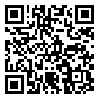Sat, Jun 28, 2025
[Archive]
Volume 8, Issue 2 (8-1994)
Med J Islam Repub Iran 1994 |
Back to browse issues page
Download citation:
BibTeX | RIS | EndNote | Medlars | ProCite | Reference Manager | RefWorks
Send citation to:



BibTeX | RIS | EndNote | Medlars | ProCite | Reference Manager | RefWorks
Send citation to:
NOORI-DALOII M, MOAZAMI N, IZADYAR M, FARHANGI S, BEYRAMI JAMAL F, ATALAY A, et al . MOLECULAR STUDIES ON THE DIST RIBUTION OF β - THALASSEMIA IN IRAN: THE BASIS FOR PRENATAL DIAGNOSIS. Med J Islam Repub Iran 1994; 8 (2) :101-107
URL: http://mjiri.iums.ac.ir/article-1-1387-en.html
URL: http://mjiri.iums.ac.ir/article-1-1387-en.html
MR NOORI-DALOII 
 , N MOAZAMI
, N MOAZAMI 
 , M IZADYAR
, M IZADYAR 
 , S FARHANGI
, S FARHANGI 
 , F BEYRAMI JAMAL
, F BEYRAMI JAMAL 
 , A ATALAY
, A ATALAY 
 , LN GEREN
, LN GEREN 
 , L AKAR
, L AKAR 
 , E ATALAY
, E ATALAY 
 , B CIRAKOGLU
, B CIRAKOGLU 
 , E BERMEK
, E BERMEK 


 , N MOAZAMI
, N MOAZAMI 
 , M IZADYAR
, M IZADYAR 
 , S FARHANGI
, S FARHANGI 
 , F BEYRAMI JAMAL
, F BEYRAMI JAMAL 
 , A ATALAY
, A ATALAY 
 , LN GEREN
, LN GEREN 
 , L AKAR
, L AKAR 
 , E ATALAY
, E ATALAY 
 , B CIRAKOGLU
, B CIRAKOGLU 
 , E BERMEK
, E BERMEK 

From the Department of Biochemistry, School of Medicine, Tehran University of Medical Sciences, Tehran
Abstract: (5672 Views)
By application of modern recombinant DNA technology, especially the
polymerase chain reaction (PCR)/dot-blot hybridization techniques, we have
investigated the molecular basis of β-thalassemia from four different regions of Iran:
central, south-east, south and north. In this study, the DNA samples were isolated
from patients and for the identification of the mutations, the 6 oligonucleotide probes
for the mutations of IVS.1/nt. 110, .lVS.1/nt.6, IVS.1/nt.1 , nonsense codon 39,
frameshift codon 8 and IVS. 2/nt.1 were selected with respect to their relative
frequency in the neighbouring country, Turkey. Four mutations accounted for76.2%
and of these, the most frequent was the nonsense codon 39 mutation, which accounts
for 60.3% of the β-thalassemia alleles tested. The remainder, in decreasing order of
frequency, wereframeshift codon 8(9.5%), lVS. 1/nt.6 (4.8%) and IVS.1/nt.11O(1.6%).
No hybridization was observed with the probes corresponding to the mutations of
rvS.I/nt I (0/ A) and rvS.2/nt.1 (0/ A). These results also revealed that the distributions
of different types of mutations were different in the four regions. This information
and the introduction to the methodology used in this study will facilitate the prenatal
diagnosis of the disease in Iran.
Type of Study: Original Research: Basic Science in Medicine |
Subject:
Biological Sciences
| Rights and permissions | |
 |
This work is licensed under a Creative Commons Attribution-NonCommercial 4.0 International License. |



